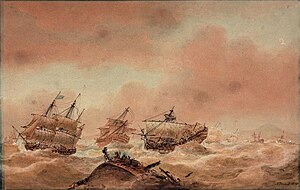HMS Euryalus (1803)

The Day after Trafalgar – The Victory Trying to Clear the Land with the Royal Sovereign in Tow to the Euryalus
|
|
| History | |
|---|---|
|
|
|
| Name: | HMS Euryalus |
| Ordered: | 16 August 1800 |
| Builder: | Balthazar & Edward Adams, Bucklers Hard |
| Laid down: | October 1801 |
| Launched: | 6 June 1803 |
| Commissioned: | June 1803 |
| Decommissioned: | 1825 |
| Reclassified: | Prison hulk, 1825 |
| Honours and awards: |
|
| Fate: | Broken up, 1860 |
| General characteristics | |
| Class and type: | Apollo-class frigate |
| Tons burthen: | 946 16⁄94 (bm) |
| Length: |
|
| Beam: | 38 ft 2 1⁄4 in (11.6 m) |
| Complement: | 264 men |
| Armament: |
|
HMS Euryalus was a Royal Navy 36-gun Apollo-class frigate, which saw service in the Battle of Trafalgar and the War of 1812. During her career she was commanded by three prominent naval personalities of the Napoleonic and post-Napoleonic period, Henry Blackwood, George Dundas and Charles Napier. After the end of the Napoleonic Wars she continued on active service for a number of years, before spending more than two decades as a prison hulk. She ended her career in Gibraltar where, in 1860, she was sold for breaking up.
Euryalus was built by Henry Adams's firm at Buckler's Hard, and launched in 1803. Her first action occurred on 2 and 3 October 1804 when, captained by Henry Blackwood, she participated in an attack on French vessels off Boulogne pier. During Blackwood's absence, Captain J. Hardy temporarily commanded her.
On 22 February 1805, Euryalus captured St Jose while on the Irish station. Dryad shared in the prize by agreement with Euryalus.
In 1805 she led a squadron of four other frigates in watching Cádiz to report the movements of the combined French and Spanish fleets anchored there. The combined fleet sailed from Cádiz on 20 October, shadowed through the night by Euryalus and the others that reported its position to the Royal Navy fleet on the horizon.
...
Wikipedia
